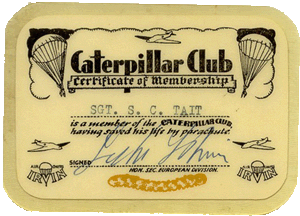
caterpillar club


The Irvin Air Chute Co. started the Caterpillar Club in 1922 and the practice of awarding the tiny gold Caterpillar Pin to anyone who saved his life by parachuting from a disabled or flaming aircraft. Each recipient of the Caterpillar Pin is living testimony to the life saving ability of the Irvin Type Air Chute. The Caterpillar is symbolic of the silk worm, which lets itself descend gently to earth from heights by spinning a silky thread to hang from. Parachutes in the early days were made from pure silk.
In 1919 Leslie Irvin, a 24-year-old stunt man from California, demonstrated the first "free drop" parachute. He had made the chute himself on a borrowed sewing machine. Flying safety experts were so impressed that the American Air Force and British R.A.F. promptly adopted the parachute as standard equipment. Later the same year, Irvin established his first factory for the mass production of parachutes in Buffalo, New York. In 1926 the first European factory was established in Letchworth, England.
During the height of World War II, production of parachutes at the Irvin Air Chute Co. factory in Letchworth, England reached a peak of nearly 1,500 parachutes per week. By late 1945 there were 34,000 members of the Caterpillar Club.
It is estimated that at least 100,000 peoples lives have been saved by Irvin parachutes.
The Irvin Aerospace Ltd. has kept all the old records, so if you need a replacement Certificate or Caterpillar Pin you may contact the following:
Yvonne Wade, Contract Specialist, (714) 619-9402 Caterpillar Club
Maureen Udy, Maureen.udy@airborne-sys.co.uk 44 1656 727 016
Pauline Benjafield, Pauline.benjafield@airborne-sys.co.uk 44 1656 727 076